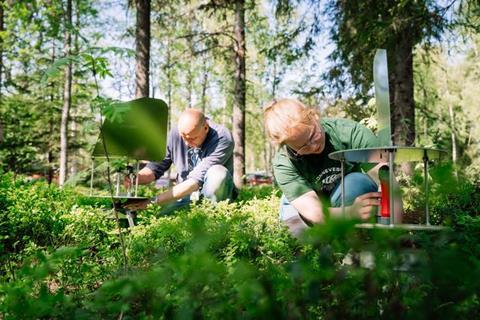Only a fraction of nature’s diversity, or species richness, is still known, especially when it comes to insects and fungi, both of which have millions of species still unknown to science. At the same time, the loss of nature is progressing at an unprecedented rate, and researchers are racing against time to find out the unknown diversity while also coming up with ways to save it.

“Air is a real treasure trove for nature research,” says Academy Research Fellow Nerea Abrego from the University of Jyväskylä. “It is full of DNA from plants, fungi, bacteria, insects, mammals and other organisms.”
Abrego led a study published in the scientific journal Nature, in which DNA sequencing was used to identify fungi from air samples collected around the world. The research produced ground-breaking knowledge about the climatic and evolutionary factors influencing the occurrence and seasonal variation of both previously known and unknown fungi.
“This knowledge is essential not only to understand where and when different fungal species thrive, but also to predict their fate under the ongoing global change,” says Abrego.
Biodiversity loss
Otso Ovaskainen, an Academy Professor at the University of Jyväskylä, was involved in the research project and he is convinced that such new biodiversity sampling techniques will revolutionize biomonitoring and biodiversity forecasts in the coming years. Using DNA as well as image and audio, Ovaskainen is leading a follow-up project in which fungi, insects, mammals, birds, bats, and frogs are studied at hundreds of locations around the world.
“There are more than million insect species in the samples already collected, which is many more species than have been described by science so far,” says Ovaskainen. “The enormous size of the data set makes analysis challenging. We have more than a hundred years of sound, millions of camera trap images, and billions of DNA sequences.”
The core activity of Ovaskainen’s and Abrego’s multidisciplinary research group is the development of statistical modeling, bioinformatics and artificial intelligence methods for using new types of biodiversity data for accurate forecasting.
Fungal diseases
Since almost all fungi are at least partially spread through the air, the study included not only boletes and russulas, but also, for example, lichens, bracket fungi, molds and yeasts.
“One particularly interesting subject for further research is a more detailed review of the sequences for fungi that are important to humans,” says Abrego. “These include fungal diseases of humans, crops and production animals, as well as fungi that indicate the progress of the loss of nature and the weakening of natural ecosystem processes.”
Abrego is leading a project where air sampling and other new research methods are being piloted as part of the regular Finnish national forest inventory coordinated by the Natural Resources Institute Finland. The goal of this project, funded by the Finnish Ministry of the Environment, is to produce comprehensive information about natural diversity, especially about previously poorly known fungi and insects, which can then be used in decision-making processes.







No comments yet